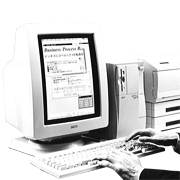The OASYS 5000G series was Fujitsu’s business word processor series sold as a total document system. Not only did these word processors enable the creation and printing of color documents, they also enabled document sharing and management in client-server configurations. Fujitsu announced three new models — the OASYS 5100G, the OASYS 5200G, and the OASYS 5300G — in July 1994 with new features, such as linkage to open networks by adding support for Microsoft Windows and local area networks (LANs).
- The OASYS 5000G series had the following features.
- (1)The OASYS 5000G series had the following features.
- Color documents could be created on-screen thanks to a color display (256 simultaneous colors from a 16.77-million-color palette). About 1,200 characters were added including phonetic symbols and European language symbols. The word processors were supplied with up to 175 versatile typefaces (42 Japanese, 92 Western, and 41 others).
- (2)New integrated human-communication interface
- This interface included multiple windows and WYSIWIG (what you see is what you get) displays. The interface also featured mouse (pointing device) operations, such as computer-like menu bars and pull-down menus, in addition to the conventional keyboard-centric functions.
- (3)Support for open network standards and client-server systems
- The word processors supported file sharing and management with NetWare server. They could also be used as Windows computers because they were loaded with Microsoft Windows 3.1.
- (4)Hardware
- The word processors ran on either a 100 MHz Intel i486DX4 or a 33 MHz Intel i486SX and came with separate accelerators for outline fonts and high-speed graphics rendering. They also supported laser-beam printers with resolutions as fine as 800 dpi at 32 lines per millimeter when printing on plain paper.
| Model name | 5100G | 5200G | 5300G |
|---|---|---|---|
| Introduced | July 1994 | July 1994 | July 1994 |
| CPU | 33 MHz i486SX |
66 MHz i486DX2 |
100 MHz i486DX4 |
| Hard drive | 260 MB | 340 MB | 530 MB |
| Floppy drive | One 3.5-inch drive, three modes*1 | ||
| Card slot | One JEIDA*2 Ver. 4.0 slot | ||
| Interfaces | Monitor (for 15-inch / 17-inch B&W monitors) SCSI*3 RS-232C*4 Centronics*5 5-inch floppy drive |
||
| Extension slots | Four However, two slots were reserved — one 64-bit bus slot for a printer connection board, and one dedicated slot for a CD-ROM / sound board |
||
| Extension memory slots | Ten Two extension RAM cards (8 MB) Four extension I/O memory cards (4 MB) Four extension I/O memory cards (8 MB) |
||
| Internal bay | One for either a 3.5-inch magneto-optical drive, a 3.5-inch floppy drive, or a 340 MB hard drive | ||
| Keyboard | Thumb shift keyboard (compliant with the NICOLA standard) or JIS keyboard | ||
| Monitors |
|
||
| External dimensions [mm] | 170 x 375 x 335 (w x d x h) | ||
| Weight | 12.7 kg | 12.8 kg | 13.0 kg |
| Power consumption | 88 W | 88 W | 90 W |
(*1) Three-mode floppy drive: supports disks in any of three capacity formats: 720 KB, 1.2 MB, and 1.44 MB.
(*2) JEIDA: Japanese Electronic Industry Development Association. JEIDA Ver. 4.0 was a PC card slot standard.
(*3) SCSI: Small computer system interface. A standard for connecting computers and peripheral devices, such as magnetic disks.
(*4) RS-232C: Recommended Standard 232 Version C. The most common standard for serial interface communications. Frequently used to connect computers and peripheral devices such as printers and modems.
(*5) Centronics is a parallel interface standard that offers faster communication speeds than serial interfaces. Commonly used to connect to printers.


